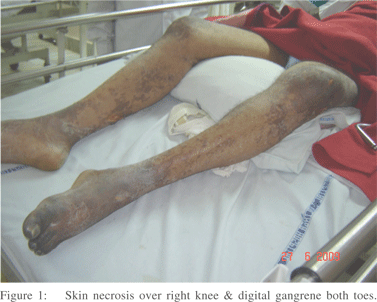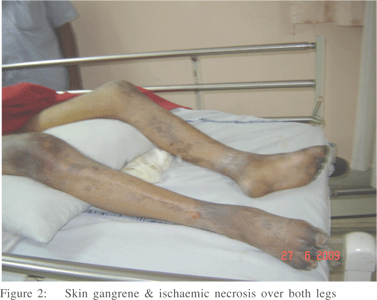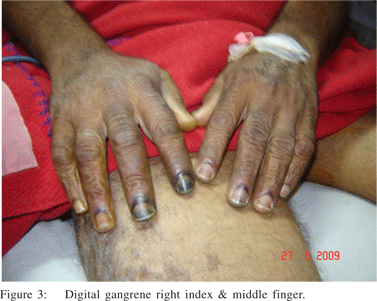48uep6bbphidvals|350
48uep6bbph|2000F98CTab_Articles|Fulltext
Terlipressin is a synthetic vasoconstrictor which is used in hepato-renal syndrome and variceal bleed. The safety profile of terlipressin is better than vasopressin. Therefore, the use of terlipressin has increased over the last few years. We report a case of terlipressin induced ischemic peripheral gangrene and ischemic necrosis of skin. Very few cases have been reported in literature. This report should increase awareness regarding the complications of this commonly used drug.
Case Report
A 50 year old male, known diabetic and alcoholic was admitted with fever of 6 days duration along with upper respiratory tract infection. He had received artesunate and ciprofloxacin. Investigations revealed Hb - 9.3g/dl, TLC - 21,000/cu mm, Platelet - 1.23 lakhs/cu mm, DLC : N-62 L-33 E-04 M-01, peripheral smear for malarial parasite – negative, , blood urea- 24 mg/dl, serum creatinine-2.8 mg/dl, Na-137 mEq/L, K-4.8 mEq/ L, random blood sugar- 150mg/dl, serum bilirubin-2 mg/dl, (direct - 0.4 mg/dl), SGOT-982 u/L, SGPT-413 u/L, Alk. Phos. - 208 u/L, LDH - 350 u/L, S. proteins.-6.1gm/dl, S. albumin-3.5gm/ dl, ECG-Normal, CXR(chest X-ray)-normal.He was provisionally diagnosed as having severe sepsis and piperacillin- tazobactum was started. empirically. He developed seizure on day one of admission and went into anuria. Injection phenytoin was started and he underwent hemodialysis.
Icterus appeared on fifth day of admission. LFT revealed S. bilirubin -17.8 mg/dl, (direct - 9.7 mg/dl), SGOT-419 u/L, SGPT- 131 u/L, Alk. Phos-225 u/L, S.proteins- 5.38 g/dl, S. albumin- 2.6 g/dl. He was provisionally diagnosed as a case of alcoholic hepatitis with hepatorenal syndrome, diabetes mellitus along with severe sepsis. Inj terlipressin was advised but not started. On Day-12 the liver function tests worsened with an increase in S. bilirubin to 32 mg/dl (direct-16.6 mg/dl). The other parameters were : SGOT-215 u/L, SGPT-95 u/L, alk. phos-839 u/ L, S.protein-5.5 g/dl, S.Alb-2.4 g/dl, PT-INR 2.4, HAV, HEV, HBsAg & HCV were negative. Inj terlipressin 1 mg 8hrly IV was started. On Day 14 ecchymosis was noticed all over body. SpO2 was not recordable in right index finger. Subsequently peripheral gangrene appeared in all four limbs. (Figure 1, 2 & 3)
Terlipressin was stopped. The hepatic failure gradually improved. (Day 15 PT/INR - 1.2. Day 16 PT/INR - 1.14). S.bilirubin-12.4 mg/dl (direct-5.8 mg/dl), SGOT-265 u/L, SGPT 58 u/L, Alk. Ph-1121 u/L, S. protein-6.5 g/dl, S.alb-2.7 g/dl. USG abdomen revealed hepatosplenomegaly. Patient was ventilated for 16 days, underwent 14 hemodialysis and had ICU stay of 26 days.



Discussion
Since its introduction in the early 1990s, terlipressin has revolutionized management of liver disease with a role in the treatment of variceal haemorrhage and hepatorenal syndrome. Terlipressin has proven to be safe, with a lower incidence of side-effects compared with vasopressin and other syntheticanalogues. Although, terlipressin is selective for the spanchnic circulation, it can exert vasoconstrictor effects on the systemic circulation. Undesirable effects are usually mild and include headache, abdominal pain and bradycardia. More serious complications are uncommon, but cases of ischaemic colitis, myocardial infarction and skin necrosis1-4 have been reported.
We believe that the skin lesion seen in this patient occurred as a result of terlipressin therapy. There is evidence for a
temporal relationship between terlipressin and the observed skin necrosis. The manufacturers of terlipressin (Ferring Pharmaceuticals Ltd, Saint-Prex, Switzerland) have received 10 reports of skin necrosis related to terlipressin use. The majority of cases are related to skin necrosis affecting the extremities, but there are also a small number of cases of foreskin and scrotal necrosis in males. Ischaemic complications as a result of vasoconstrictor medication usually affect peripheral areas such as the digits of the hands and feet.
This case suggests extra vigilance is warranted while administering terlipressin. Although ischemic complication with terlipressin is rare, we should be aware of it and detect it early
References
1. Lee JS, Lee HS, Jung SW, Han WS, Kim MJ, Lee SW, et al. A case of peripheral ischemic complication after terlipressin therapy. Korean J Gastroenterol 2006;47:454–7.
2. Oh JE, Ha JS, Cho DH, Yu GJ, Shim SG. A case of ischemic skin necrosis after glypressin therapy in liver cirrhosis. Korean J Gastroenterol. 2008;51:381–4.
3. Donnellan F, Cullen G, Hegarty JE, McCormick PA. Ischaemic complications of Glypressin in liver disease: a case series. Br J Clin Pharmacol 2007;64:550–2.
4. Di Micoli A, Bracci E, Cappa FM, Casadio R, Zambruni A, Fontana K, et al. Terlipressin infusion induces ischemia of breast skin in a cirrothic patient with hepatorenal syndrome. Dig Liver Dis. 2008;40:304–5.